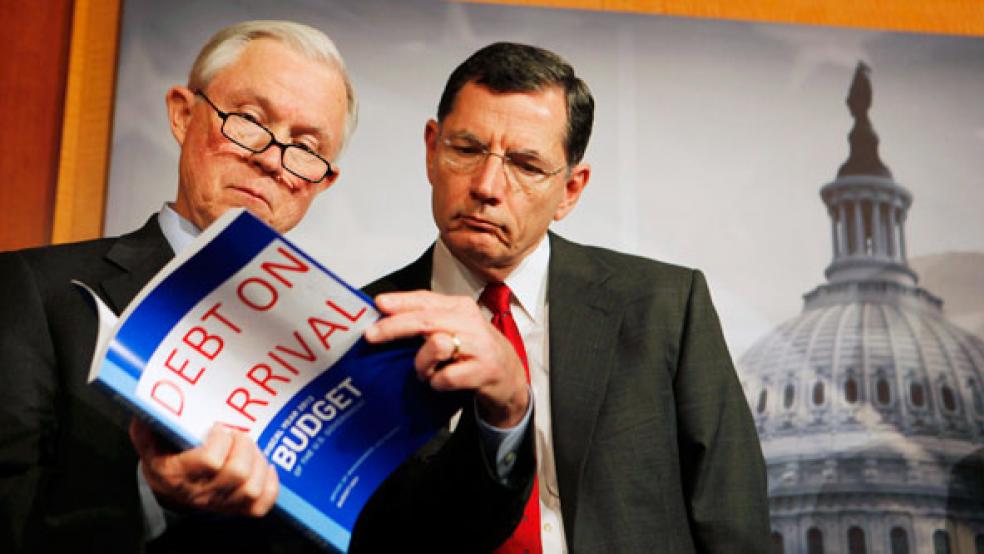It is now commonplace to say this year’s presidential election will be the most momentous since at least 1980. President Obama’s budget released Monday underscores what’s at stake when voters trek to the polls in November – the future of America’s safety net for the nation’s elderly and poor.
RELATED: Obama's 'Campaign' Budget: The Winners and Losers
Forget about spending and deficit numbers that total in the trillions of dollars. Most Americans can’t wrap their minds around numbers that large. Rather, imagine the nation’s economy is a pie, and ask yourself what share of that pie the government ought to take in to carry out the tasks it has been asked to perform by Congress. That would include providing for the common defense, teaching the young, protecting the environment, building roads and bridges and supporting medical science – the so-called discretionary budget.
But it also includes providing pensions for the elderly, health care for the poor and elderly, and taking care of the disabled and unemployed. These entitlement programs – some prefer the less pejorative term social insurance – make up the safety net for society’s most vulnerable citizens.
Before you pick up your tri-cornered hat and shout that we ought to be doing “less than before” for these groups (the irony, of course, is that many members of the Tea Party simultaneously shout “don’t you dare touch my Medicare and Social Security”), take a moment to ponder what this nation will look like ten years from now. That’s when the front edge of the 77 million baby boomers will have retired. The share of society over 65 is about to rise from its current 15.7 percent of the population to 19 percent in 2020 to 22.5 percent 2030. That is the year when the last of the boomers, those born in 1965, become eligible for Medicare.
On the campaign trail and on Capitol Hill, Republicans running for president and the party’s legislative leaders say the U.S. government shouldn’t take more than 18 percent of the gross domestic product (GDP – think of it as the national pie) to provide for both discretionary and entitlement programs. That’s about the average of the last 30 years. It is a number that does not recognize any need to make special provision for the baby boom’s retirement, and reflects the Republican Party’s central political plank – the maintenance of all of the Bush-era tax cuts and no further tax increases, not now, not ever.
The president’s budget plan, on the other hand, says higher taxes have got to be part of the equation. The budget does slice domestic discretionary spending to its lowest level since the 1950s. It makes modest cuts in military spending. And it even pares away at medical programs for the elderly and poor – another $360 billion over the next ten years on top of the $500 billion included in the Affordable Care Act, the president’s signature health care reform law.
The tax increases in the president’s plan reflect the populist theme of his emerging campaign. It raises taxes on families earning over $250,000 a year as well as on banks and oil companies. Even though the president’s budget only raises $1 in new tax revenue for every $2.50 in budget cuts, it would allow the government to continue spending at a rate that’s 22.8 percent of economic output. At the end of the next decade, he would stabilize the nation’s debt as a share of GDP at about 67 percent.
If you think that level of spending is profligate, look at what it will entail to get to that point. National security spending, which includes homeland security, would fall under the Obama plan from 5.6 percent of GDP in 2012 to 3.4 percent of GDP in 2022. Domestic discretionary spending – that everything from the environment to housing to medical research, and the like – would fall from 2.9 percent to 1.7 percent of GDP.
It’s not like entitlement programs would soar under the plan. In fact, they would remain at the same 14.4 percent of GDP that they are today, largely because the budget plan projects that most of the safety net spending on the unemployed and special tax breaks to spur economic demand (the payroll tax cut) will go away. Spending on Social Security, Medicare and Medicaid, on the other hand, will rise from 9.7 percent of GDP in 2012 to 11.2 percent in 2022.
Even as he released his budget, the president was already focused on his short-term objective – keeping the economy on track in the rest of this election year. A stellar year of economic growth will bolster his electoral changes far better than anything in this week’s budget proposal.
The economy got off to a good start in January when the unemployment rate fell to 8.3 percent. The budget plan projects economic growth will be 3 percent this year. While that’s not hefty by historic standards for an economy coming out of recession, it is well above what either the Congressional Budget Office or most private economic forecasters are predicting.
To get that growth, Obama needs to get Congress to go along with continuing the payroll tax cut and extended unemployment insurance for the rest of the year. “The last thing we need is for Washington to stand in the way of America’s comeback,” he told a crowd of college students in northern Virginia, where he unveiled the budget. “Congress needs to stop taxes from going up on 160 million Americans by the end of this month. If they don’t act, that’s exactly what will happen. The time for self-inflicted wounds to our economy has to be over.”
If that fails, it’s likely that economic growth will falter. Then, the budget deficit will resume rising, the president’s re-election chances will slide, and the future of America’s safety net will be very much in doubt.






